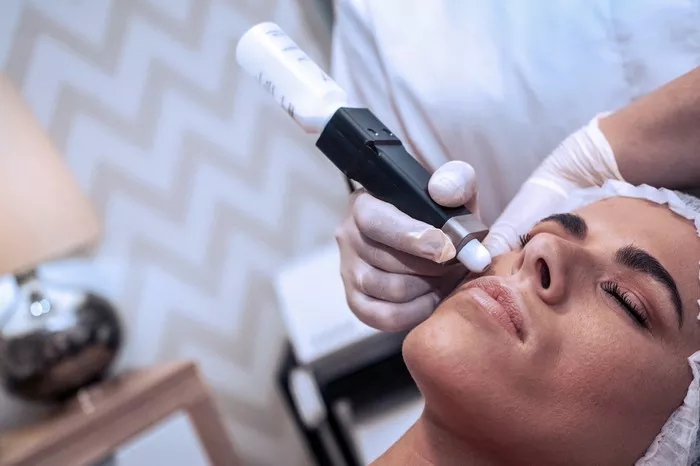Microdermabrasion is a popular cosmetic procedure that can help improve the appearance of the skin by removing dead skin cells and promoting cell turnover. It is a non-invasive procedure that is often used to treat acne scars, age spots, fine lines, and wrinkles. One of the most common questions people have about microdermabrasion is how long it takes to heal from the procedure. In this article, we will explore the healing process after microdermabrasion and provide some tips for a faster recovery.
What is microdermabrasion?
Microdermabrasion is a cosmetic procedure that involves using a handheld device to exfoliate the outermost layer of the skin. The device uses a stream of fine crystals or a diamond tip to remove dead skin cells and promote the growth of new, healthy skin cells. The procedure is typically performed by a licensed esthetician or dermatologist and can be done in a clinic or spa setting.
How does microdermabrasion work?
During a microdermabrasion treatment, the esthetician or dermatologist will first clean and dry the skin. They will then use a handheld device to gently exfoliate the skin with a stream of fine crystals or a diamond tip. The device also suctions away the dead skin cells and any other debris, leaving the skin looking smoother and brighter.
Microdermabrasion can be performed on the face, neck, chest, arms, and hands. The treatment is usually painless and does not require any anesthesia or downtime. Most people can return to their regular activities immediately after the procedure.
How long does it take to heal from microdermabrasion?
The healing time after microdermabrasion can vary depending on several factors, including the individual’s skin type, the intensity of the treatment, and the area being treated. In general, the skin may appear slightly red and sensitive immediately following the procedure, but this usually subsides within a few hours.
-
First 24 hours after microdermabrasion
During the first 24 hours after microdermabrasion, it is important to avoid any activities that could irritate the skin. This includes sun exposure, hot showers or baths, saunas, and swimming. You should also avoid using any products that contain harsh chemicals or fragrances.
-
Second to third day after microdermabrasion
By the second to third day after microdermabrasion, the skin may start to feel dry and flaky. This is a normal part of the healing process and indicates that the dead skin cells are being sloughed off. To help speed up the healing process, you should use a gentle, non-comedogenic moisturizer to keep the skin hydrated.
-
Fourth to fifth day after microdermabrasion
Around the fourth to fifth day after microdermabrasion, the skin may start to peel or flake off in larger pieces. This is also a normal part of the healing process and should not be picked or scratched. Instead, you should continue to use a gentle moisturizer and avoid any harsh exfoliants or scrubs.
-
Sixth to seventh day after microdermabrasion
By the sixth to seventh day after microdermabrasion, the skin should start to look and feel smoother and more radiant. However, it is still important to avoid any activities that could irritate the skin, including sun exposure and harsh chemicals.
Tips for a faster recovery after microdermabrasion
To help speed up the healing process after microdermabrasion, here are some tips you can follow:
- Use a gentle, non-comedogenic moisturizer to keep the skin hydrated.
- Avoid any activities that could irritate the skin, such as sun exposure and hot showers.
- Avoid using any products that contain harsh chemicals or fragrances.
- Drink plenty of water to keep the skin hydrated from the inside out.
- Avoid picking or scratching at the skin, as this can cause scarring and infection.
- Use a broad-spectrum sunscreen with an SPF of 30 or higher to protect the skin from UV damage.
- Follow any specific aftercare instructions provided by your esthetician or dermatologist.
- Consider scheduling follow-up treatments to maintain the results of your microdermabrasion.
When to see a doctor after microdermabrasion
While microdermabrasion is a safe and effective procedure, there are some potential side effects and complications to be aware of. If you experience any of the following symptoms after microdermabrasion, you should contact your doctor right away:
- Severe pain or discomfort
- Excessive redness, swelling, or bleeding
- Signs of infection, such as fever, chills, or pus
- Allergic reaction, such as hives or difficulty breathing
- Persistent or worsening skin discoloration or scarring
Conclusion
Microdermabrasion is a popular cosmetic procedure that can help improve the appearance of the skin by removing dead skin cells and promoting cell turnover. While the healing time after microdermabrasion can vary depending on several factors, most people can expect to see results within a week of the treatment. To help speed up the healing process and maintain the results of your microdermabrasion, it is important to follow proper aftercare instructions and avoid any activities that could irritate the skin. If you experience any concerning symptoms after microdermabrasion, be sure to contact your doctor right away.

